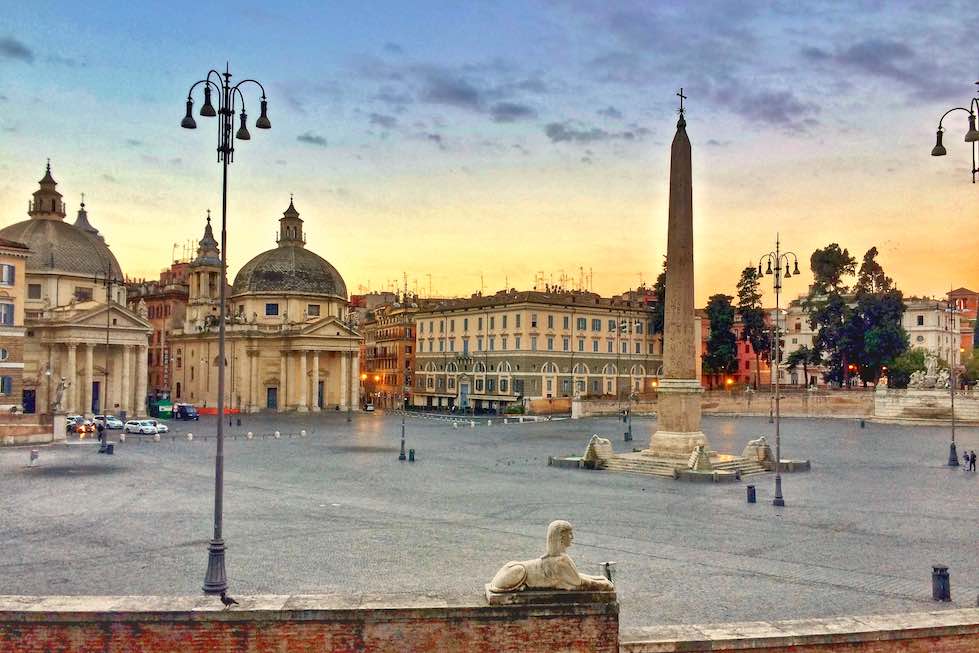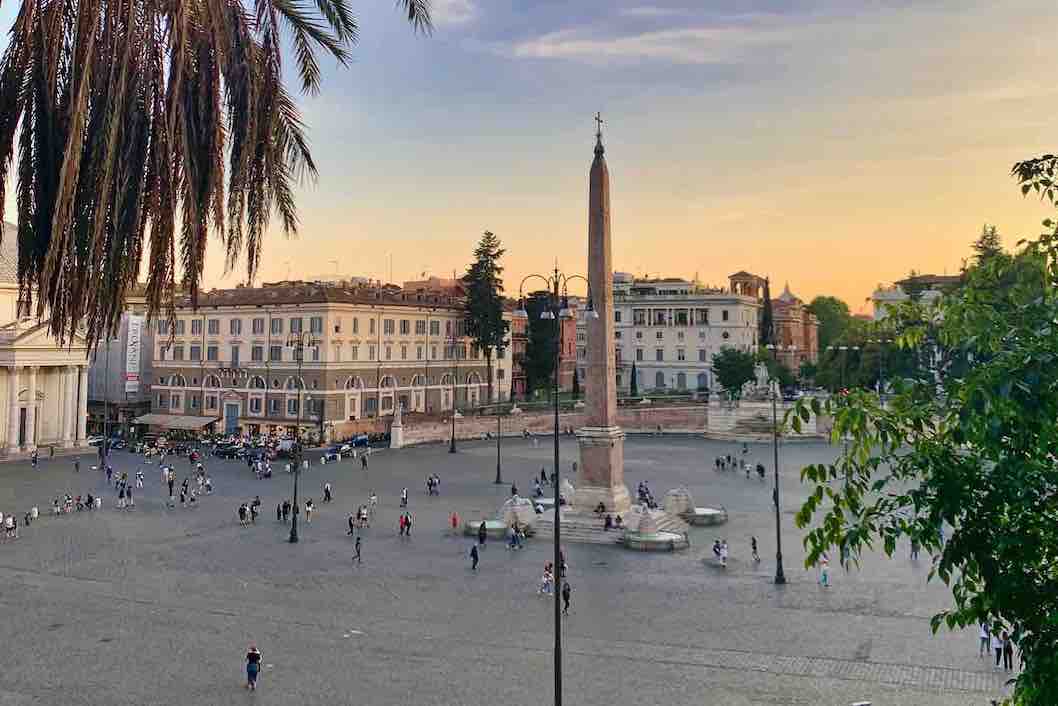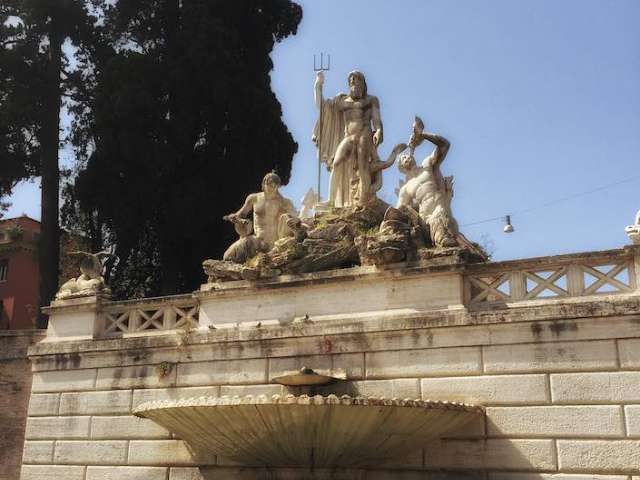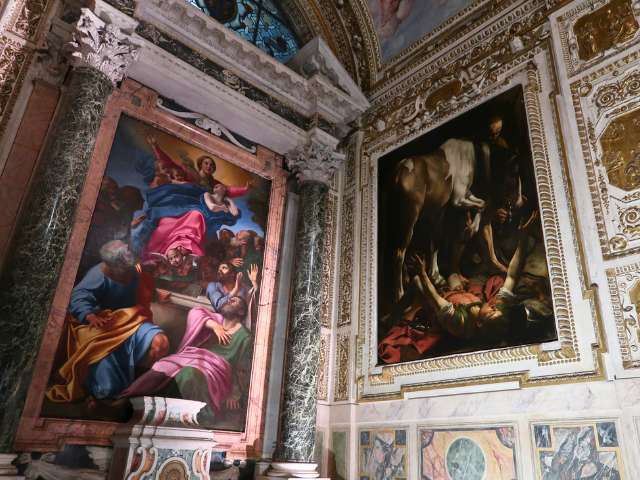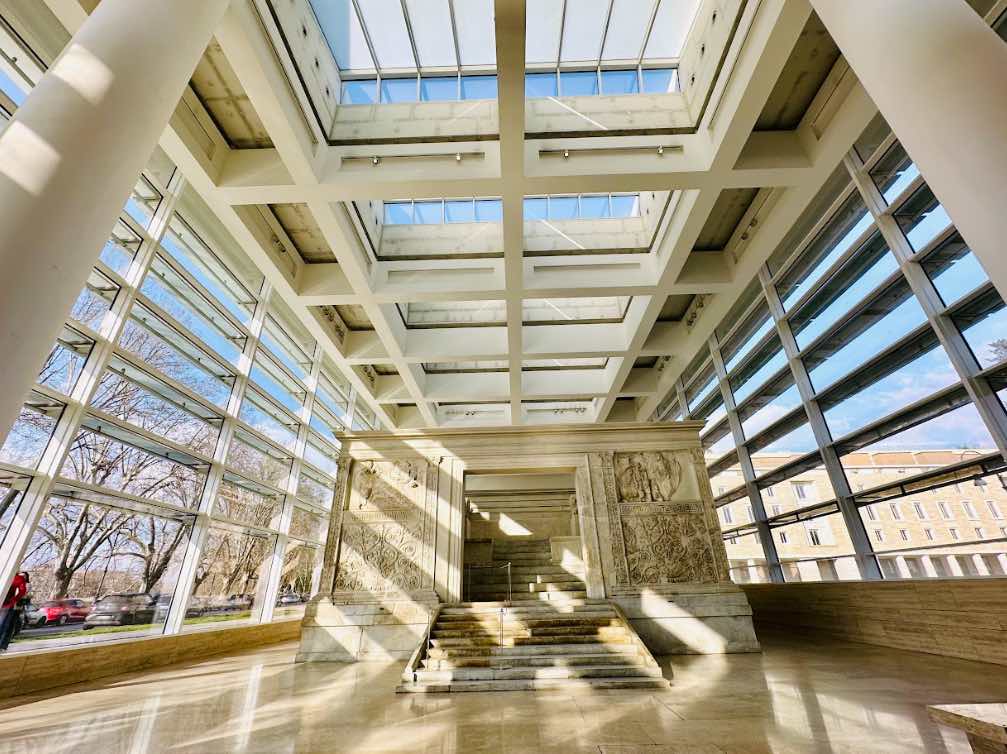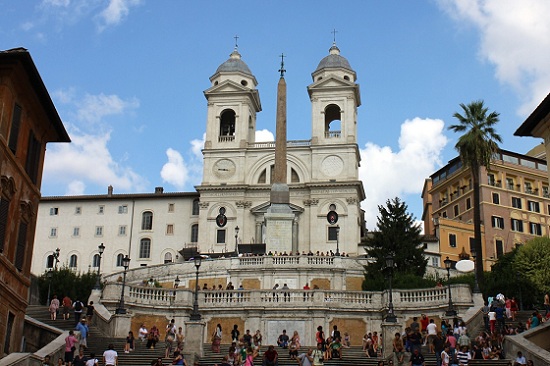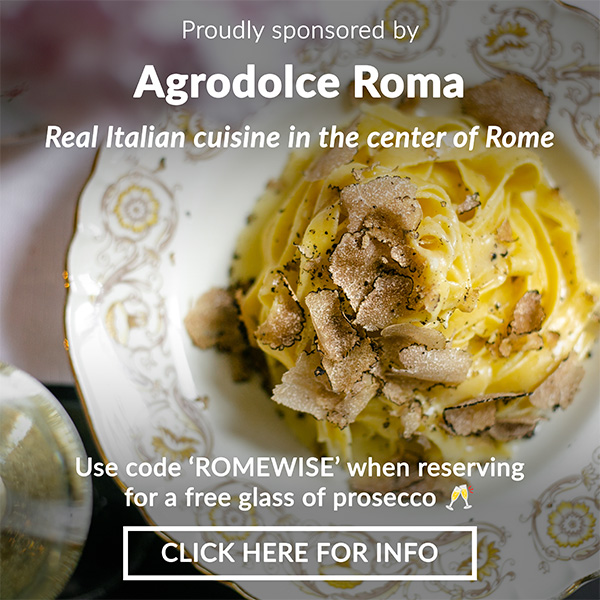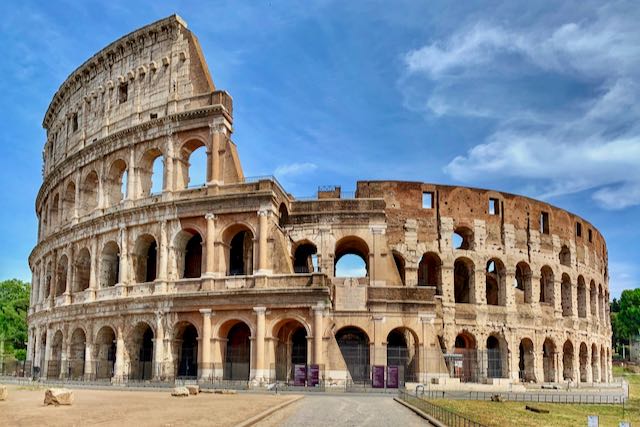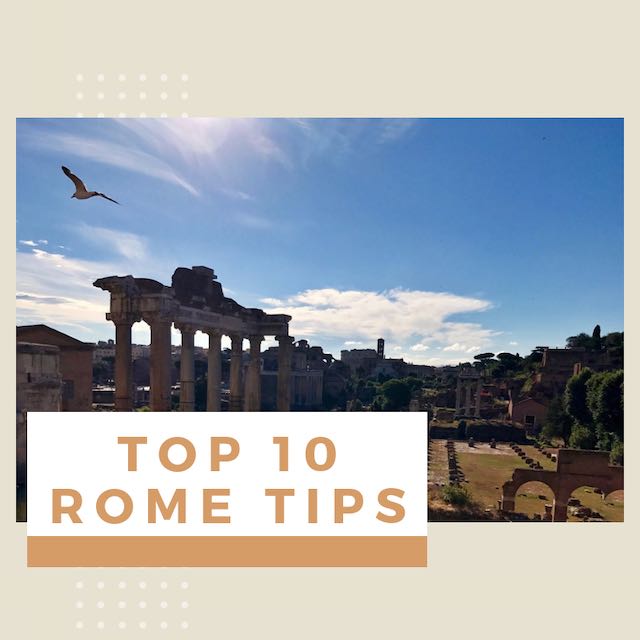- Sign up & get a FREE ebook Subscribe NOW!
- Romewise Home Page
- What to Do in Rome
- Piazza Del Popolo
Piazza del Popolo Rome - What to see and do
Piazza del Popolo is a central part of Rome's historic center, but many people see it as a stopping point on the way to somewhere else.
From an Egyptian obelisk to beautiful churches there is a lot to see and do in this square, keep reading to find out more!
Piazza del Popolo - Everything you need to know
Piazza del Popolo, nestled in Rome's historic center, holds plenty of historical and architectural sights to be discovered.
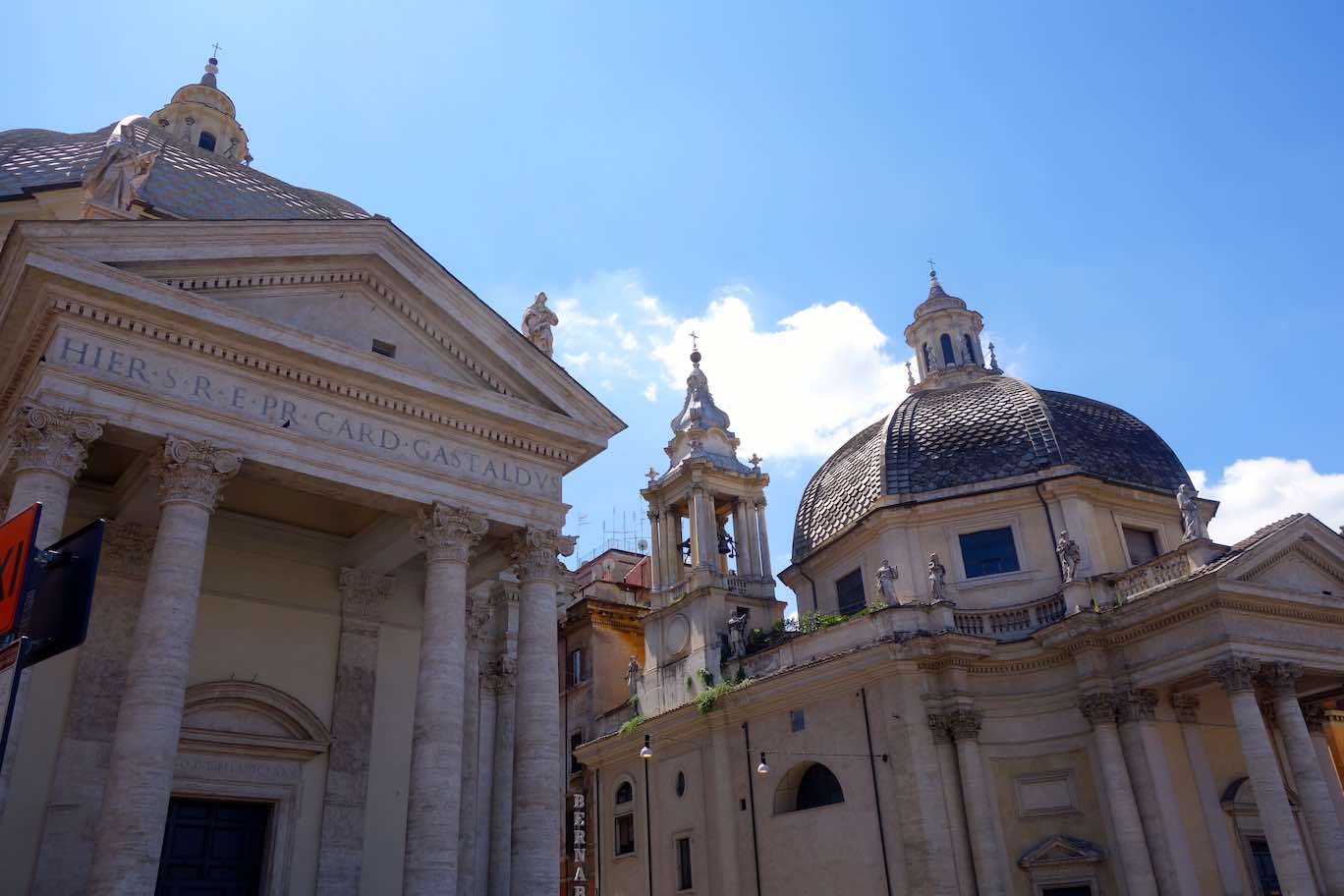 The main streets leading off the piazza are flanked by these matching churches on the opposite side to the gateway
The main streets leading off the piazza are flanked by these matching churches on the opposite side to the gatewayWith its ancient obelisk and charming churches, this square offers a captivating glimpse into Rome's past.
On this page we'll cover:
- The history of Piazza del Popolo
- The architectural design of Piazza del Popolo Rome
- What there is to see in Piazza del Popolo
- What there is to do nearby
- How to get to Piazza del Popolo
The history of Piazza del Popolo
Piazza del Popolo is one of Rome's most iconic squares.
Once an ancient meadow, it was reborn in Renaissance grandeur by architects like Domenico Fontana and Gian Lorenzo Bernini.
At its heart stands the ancient Egyptian obelisk, erected in 1589.
Additionally, the so-called “twin churches” of Santa Maria dei Miracoli and Santa Maria in Montesanto, face off at the square's helm.
During a short Napoleonic stint, the square bore the name "Place Bonaparte" before reclaiming its original moniker after Italian unification.
Today, it's a dynamic epicenter for events, encircled by shops and restaurants, and is a must visit location in Rome!
Wondering where the name 'Popolo' came from?
While 'Piazza del Popolo' in modern Italian translates to 'People's Square', the name actually derives from the Latin word Populus which refers to poplar trees.
A grove of poplar trees surrounded the tomb of ancient Roman emperor Nero in this area, whose ruins are still below the Basilica of Santa Maria del Popolo today!
Piazza del Popolo in Ancient Rome
In ancient times the piazza was known as the Porta Flaminia, named after the nearby gate which marked the northern entrance to the city.
This northern gate was a crucial point along the Via Flaminia, one of Rome's most significant roads, connecting the city to the northern regions of Italy.
The surrounding area was an essential thoroughfare and a hub of activity for travelers and traders entering Rome.
Later, during the 3rd century, the Aurelian Walls were constructed, incorporating the gate into the city's formidable defensive fortifications.
This evolution solidified the square's importance in Rome's urban history.
Piazza del Popolo during the Renaissance
In the Renaissance era Piazza del Popolo witnessed a profound renovation.
Architects of renown spearheaded the transformation, introducing elegant fountains and lavishly adorned churches.
The ancient Porta Flaminia, now revamped in the prevailing architectural style, served as a striking entry point to the square.
This Renaissance revival not only elevated the square's visual allure but also underscored its renewed cultural and social importance within the heart of Rome.
Piazza del Popolo today
Today Piazza del Popolo stands as a living testament to its rich history.
In the 1800's, the square underwent another set of renovations, giving it the appearance we see today.
However, it wasn't until the 1990's that a significant change took place: the square was pedestrianized.
This shift has allowed visitors to fully enjoy the square without the presence of cars, making it an ideal location for strolling at the heart of Rome.
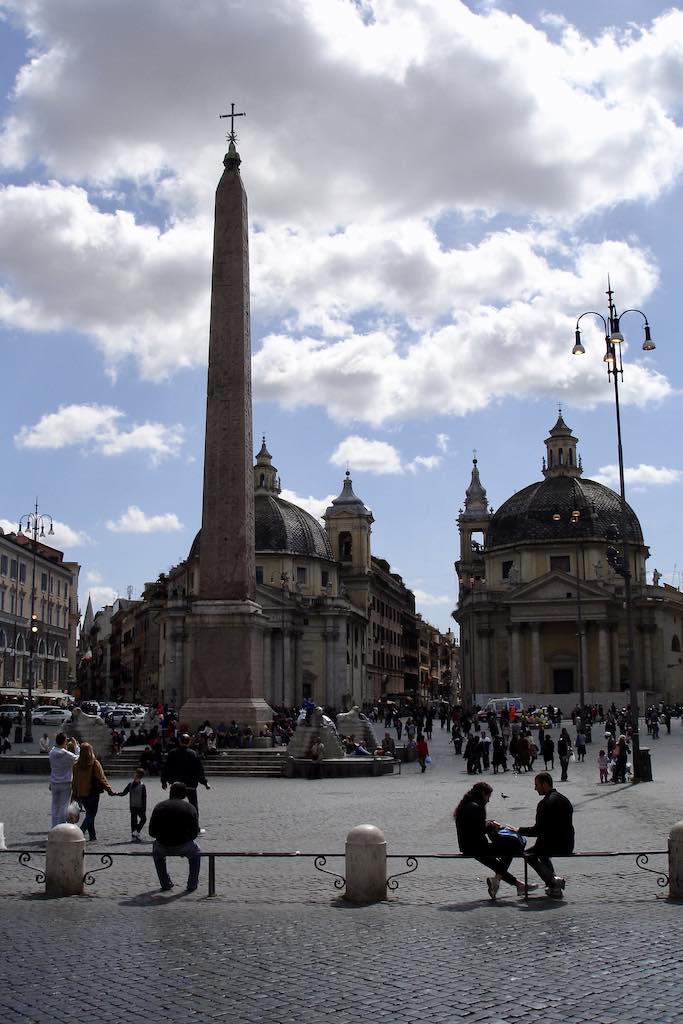 Being able to walk around the piazza without worrying about cars whizzing past has hugely improved its appeal!
Being able to walk around the piazza without worrying about cars whizzing past has hugely improved its appeal!The architectural design of Piazza del Popolo
Piazza del Popolo boasts a rich tapestry of architectural styles spanning centuries.
Its design weaves together influences from ancient Rome, Renaissance enhancements, and modern adaptations.
The gateway to the Eternal City
Piazza del Popolo, often referred to as the "Gateway to the Eternal City", welcomed visitors entering Rome.
Three major roads branch from this central square, each bearing historical and symbolic weight.
 The three roads, one on the east side, one central and one on the west, lead away from the city gate
The three roads, one on the east side, one central and one on the west, lead away from the city gateThe Via del Corso, formerly the ancient Via Flaminia, stretches southward, linking Rome to the heart of the city.
The Via di Ripetta leads towards the Tiber River, serving as a connection to the city's waterfront.
Lastly, the Via del Babuino extends towards the Spanish Steps, linking Piazza del Popolo to another iconic Roman landmark.
These three roads not only facilitate movement within the city but also represent historical streets that have sustained Rome's vitality throughout the ages.
Pope Sixtus V's vision
As part of Pope Sixtus V's broader urban planning initiative for Rome, his vision for Piazza del Popolo aimed to bring about substantial changes.
Recognizing the historical and symbolic value of the ancient Egyptian obelisk, he arranged for its relocation to the center of the square.
Additionally, under his guidance, the grand Porta del Popolo was constructed, serving as an impressive gateway to the city which was then undergoing a period of revitalization.
Baroque additions
The Baroque era brought significant additions to the piazza, leaving a strong mark on its architectural landscape.
Notable among these are the two identical churches, Santa Maria dei Miracoli and Santa Maria in Montesanto, which flank the northern end of the square.
Their Baroque facades, designed by Carlo Rainaldi, are so similar that they have been dubbed the “twin churches” of the piazza.
Additionally, the sculptor and architect Bernini undertook a renovation of the Porta del Popolo during this period.
His work on the gate incorporated Baroque elements, contributing to the overall aesthetic unity of the square.
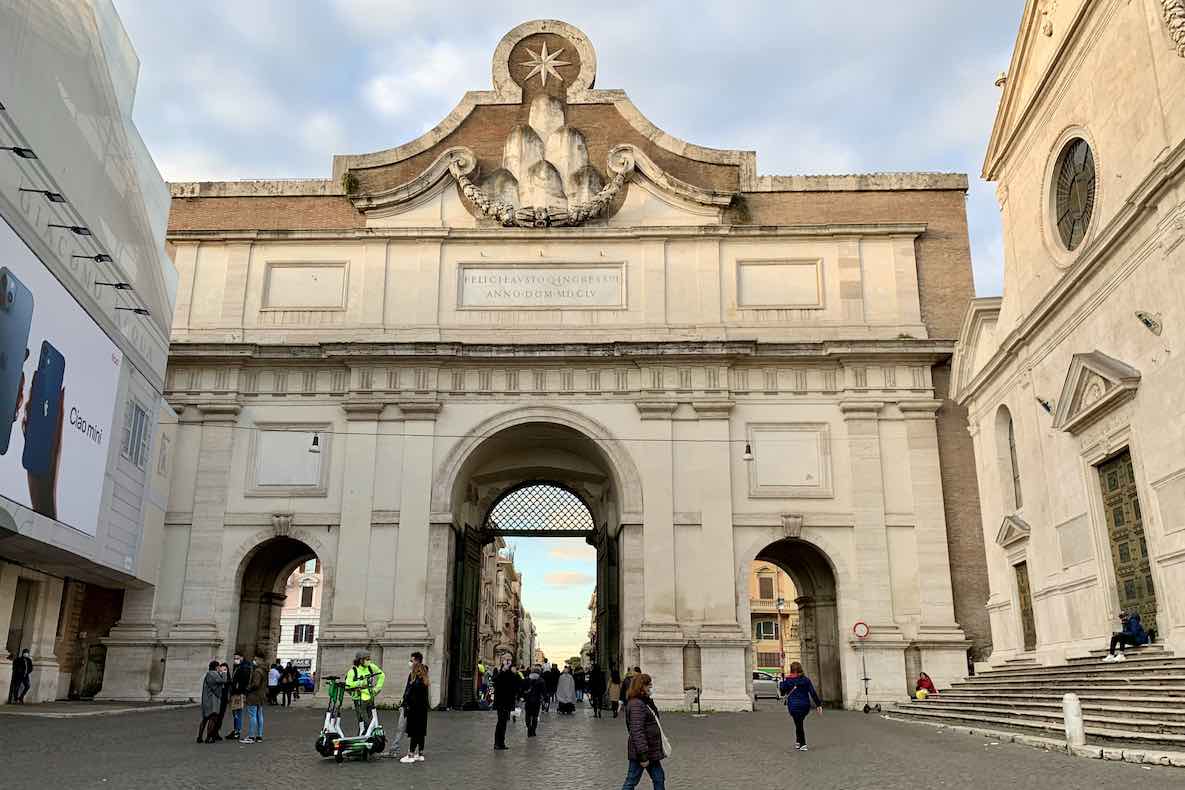 Both the large city gate and church (on the right) were renovated by Bernini to make them match the rest of the piazza
Both the large city gate and church (on the right) were renovated by Bernini to make them match the rest of the piazzaBernini also worked on the external facade of the church of Santa Maria del Popolo, located adjacent to the gate.
His intervention enhanced the church's exterior, giving it a more grandiose and visually striking presence.
These Baroque additions, with their intricate details and masterful craftsmanship, further enriched the allure of Piazza del Popolo during this period in Roman history.
Giuseppe Valadier
Architect Giuseppe Valadier, a prominent figure in 19th century Roman architecture, played a pivotal role in the modern regeneration of Piazza del Popolo.
His visionary renovations included the installation of two fountains, the Fontana dell'Obelisco and the Fontana del Nettuno, and adding the Egyptian style lions to the central structure around the Flaminio obelisk.
 These lions were an inspired addition - I love seeing person after person take pictures in front of them
These lions were an inspired addition - I love seeing person after person take pictures in front of themMoreover, Valadier orchestrated the construction of the road leading up to the Pincio hill terrace.
This thoroughfare not only offers a picturesque approach to the Pincio hill, but also provides visitors with breathtaking panoramic views of Rome.
Valadier's contributions stand as enduring testaments to his influence on the aesthetics and accessibility of Piazza del Popolo.
What there is to see in Piazza del Popolo
When you visit Piazza del Popolo, you'll have lots of attractions to choose from!
From the Egyptian obelisk to three churches, there is plenty here to explore:
Santa Maria del Popolo
Santa Maria del Popolo, situated on the northern edge of the piazza, has a rich history dating back to the 11th century.
Its current structure, primarily in the Renaissance and Baroque styles, was shaped by notable architects like Baccio Pontelli and Gian Lorenzo Bernini.
Throughout history, Santa Maria del Popolo has played a significant role, serving as the burial site for several prominent figures, including Pope Pius IV.
Its importance was further solidified by artistic contributions, notably Caravaggio's masterpieces "The Conversion of Saint Paul" and "The Crucifixion of Saint Peter," which adorn the Cerasi Chapel.
The church also houses works by Raphael, Bernini, and Pinturicchio.
The church also houses works by Raphael, Bernini, and Pinturicchio.
Inside, visitors can explore various chapels, each offering a unique artistic and historical experience.
Noteworthy among these is the Chigi Chapel, designed by Raphael, and the Cybo Chapel, adorned with stunning fresco paintings by Pinturicchio.
Santa Maria del Popolo is open to visitors from 7:00 AM to 12:00 PM and from 4:00 PM to 7:00 PM every day except Thursdays when it's closed, so you'll have plenty of chances to appreciate its architectural splendor and artistic treasures.
Central obelisk
Originally quarried in ancient Egypt, the obelisk was crafted around 1200 BCE during the reign of Pharaoh Ramses II.
It was erected in the city of Heliopolis, where it stood for centuries as a symbol of Egyptian grandeur.
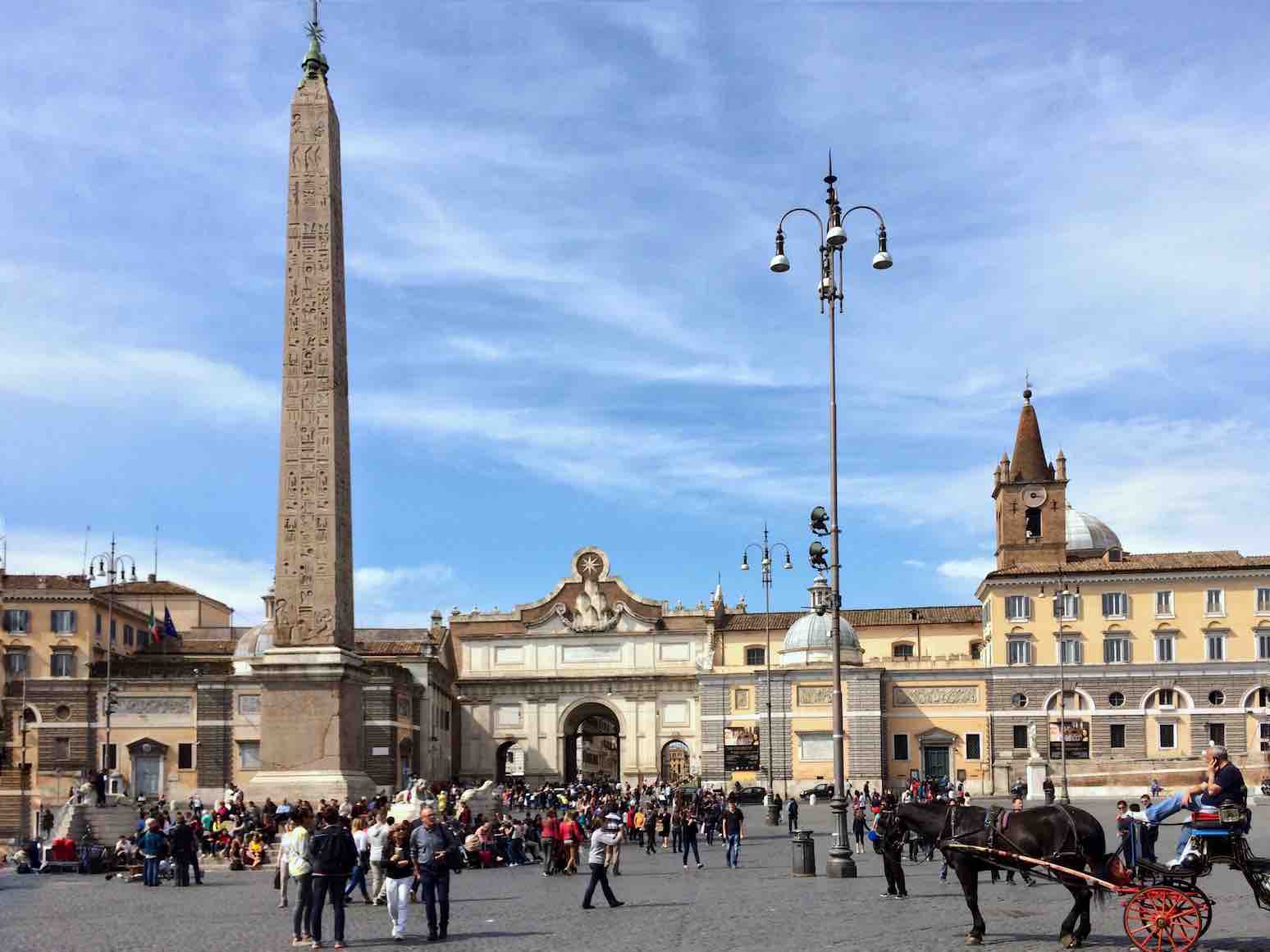 Only when you take a few steps back do you see how well the obelisk placement works with the rest of the piazza
Only when you take a few steps back do you see how well the obelisk placement works with the rest of the piazzaIn 10 BCE, the Roman Emperor Augustus ordered the obelisk to be transported to Rome.
It was one of several obelisks brought to the city during this period to enhance the architectural splendor of Rome and commemorate Roman military victories.
The obelisk was placed in the Circus Maximus, a vast chariot racing stadium, where it stood for centuries, before being moved to its current place in the People's Square in 1589.
Porta del Popolo
Porta del Popolo, originally known as Porta Flaminia, has ancient origins dating back to the Roman Empire.
It was part of the Aurelian Walls, a defensive fortification built in the 3rd century and served as a crucial entry point for travelers entering the city from the north, particularly those arriving from the Via Flaminia.
In the 16th century, Pope Sixtus IV commissioned a redesign of the gate, giving it a more monumental and decorative appearance.
Bernini later undertook further renovations, infusing Baroque elements into the structure.
The gate's present-day appearance reflects these enhancements.
While the gate itself is not typically open to the public for exploration inside, the square surrounding the gate is open to explore.
The twin churches
The matching two churches, located at the northern end of the piazza, were constructed in the 17th century.
Commissioned by Pope Alexander VII, they were designed by Carlo Rainaldi and serve as remarkable examples of Roman Baroque architecture.
While these churches are often referred to as "twins," they are not in fact identical.
Each possesses its own distinct character and features, despite their similar layout and facade.
Santa Maria in Montesanto is known for its elegant concave facade, while Santa Maria dei Miracoli features a convex design.
Together, they create a harmonious and visually striking presence at the entrance to Piazza del Popolo.
Visitors can explore the interiors of both churches, which both have stunning artwork and ornate decoration.
Santa Maria in Montesanto houses a painting of the Virgin Mary attributed to Caravaggio, adding to its artistic significance.
The churches are generally open to visitors from 7:30 AM to 12:00 PM and from 4:00 PM to 7:00 PM daily.
However, it's advisable to check for any updated opening hours or special events that may affect visitation.
Leonardo da Vinci museum
The Leonardo da Vinci Museum in Rome takes visitors on a captivating journey into the inventions of Leonardo da Vinci.
It features a collection of interactive exhibits and detailed reproductions of his inventions, offering visitors a hands-on experience of his innovative creations.
This museum is an excellent destination for families, as it provides an engaging and educational experience for both children and adults.
The museum's opening hours are typically from 10:00 AM to 7:00 PM, making it accessible for visitors throughout the day.
However, I always recommend that you double check before visiting for any updated hours or potential closures.
I find these smaller museums sometimes make changes with very little notice!
Ready to plan your trip?
Book your train
Planning to travel between cities in Italy and other parts of Europe?
Use Trainline to see all the different options available across the different rail companies.
Find your hotel
Find your perfect place to stay in Rome.
Use Booking.com to choose between hotels, guesthouses, and self-catering apartments in neighborhoods throughout the Eternal City.
Buy your TurboPass
Purchase the convenient Turbopass and visit all of Rome's top attractions including the Colosseum, Pantheon, and Vatican.
With one handy pass, it's all included.
What there is to do nearby
The area around Piazza del Popolo is teeming with cultural and historical treasures, offering a diverse array of experiences for visitors.
Pincio Terrace and Villa Borghese park
The Pincio Terrace and Villa Borghese park are serene spots located near Piazza del Popolo, reached by walking up the hill.
The Pincio Terrace is a popular spot, especially at sunset, with views of Rome's skyline.
Villa Borghese is a large park with green spaces, a boating lake, winding paths through the trees and at the far end, the Galleria Borghese.
Ara Pacis and Mausoleum of Augustus
The Ara Pacis, an ancient Roman altar commissioned by Emperor Augustus, has detailed reliefs depicting scenes of Roman life and mythology and is amazingly well preserved.
The Mausoleum of Augustus, a monumental tomb, stands as a testament to his legacy across the road from the Ara Pacis museum.
To reach both sites from Piazza del Popolo, simply head south on Via di Ripetta.
The Ara Pacis is located slightly closer to the square, while the Mausoleum of Augustus is situated a bit further south, near the Tiber.
Don't forget to bring these essential travel items with you!
Disclosure: If you make a purchase through a link on this page, I may receive a small commission - at no extra cost to you. Thank you for supporting my site!
Spanish Steps
The Spanish Steps, located in Piazza di Spagna, are one of Rome's most famous landmarks.
This grand staircase is a popular gathering spot and a picturesque setting for visitors and locals alike.
At the top of the steps stands the Trinità dei Monti Church, an elegant French church with a stunning facade.
To reach the Spanish Steps from Piazza del Popolo, take a leisurely stroll down Via del Corso, and you'll arrive at Piazza di Spagna in about 10-15 minutes.
Shopping
I love shopping in this area, with lots of stores to explore.
Via del Corso is a bustling shopping street featuring a mix of international brands and department stores.
Via del Babuino, near Piazza del Popolo, offers high-end designer boutiques and luxury brands and Via Margutta is known for its art galleries, antique shops, and artisan workshops, providing a more artistic and eclectic shopping experience.
Whether you're after fashion, luxury items, or unique artisanal finds, these streets cater to a wide range of shopping preferences in Rome.
The perfect 3-day itinerary in Rome
Trying to figure out how to organize your visit to Rome? I've got the perfect 3-day itinerary for first-time visitors (or those who have not been here in a while.) It works for a 2.5 day visit as well.
In my 3-day itinerary, you'll see all the major must-see Rome attractions like the Vatican, Colosseum, Trevi Fountain, Pantheon, Piazza Navona, Spanish Steps, Castel Sant'Angelo, and much more.
And if you have more time, or want suggestions for extra/other things to do, you'll find that there too.
Visit my page with the best 3-day itinerary in Rome for first-timers.
How to get to Piazza del Popolo
To reach Piazza del Popolo, there are several convenient transportation options.
If you're taking the metro, get on Line A and get off at the Flaminio stop.
This station leads directly to the piazza.
Additionally, many bus lines have stops near Piazza del Popolo, so it's easy to reach from all over the city.
You can also walk to the piazza from some of Rome's most famous landmarks, one of the major benefits of Rome's historic center being so small!
 Behind the Neptune fountain you'll find a short path to a bridge over the Tiber, which will take you all the way to the Vatican
Behind the Neptune fountain you'll find a short path to a bridge over the Tiber, which will take you all the way to the VaticanStarting from the Vatican, a picturesque walk along the Tiber River to the piazza will take approximately 30-40 minutes.
From the Trevi Fountain, a straightforward route will lead to Piazza del Popolo in about 25-30 minutes, allowing for you to explore charming Roman streets along the way.
If you're setting off from the Colosseum, allocate around 50-60 minutes for the walk, which will give you an opportunity to discover historic neighborhoods en route.
Romewise's Top Travel Resources
Ready to book your trip to Rome? Take a look at these helpful links to companies we use and trust:
- Keep your travel spending simple with the Wise card, which removes all the worry about exchange rates and high transaction fees all over the world
- Search for and book your perfect accommodation
- Our complete guide to what to pack for Rome
- The number one travel accessory, a multi-point travel adapter and voltage converter
- Browse a huge range of tours in Rome and beyond
- Experience unique tours and special access to Rome's most popular sights
- Protect yourself with comprehensive travel insurance
Within this post there are some affiliate links for products and services. For more details about our affiliate policy click here.
Get your 100% free Rome trip planner now!
Simply sign-up today for our free newsletter and get the Romewise Quick Start guide to Rome:
We are committed to respecting your data. Click for our Privacy Policy.
Comments? Questions? Suggestions?
Please come over to the private Romewise Facebook group and join in the conversation.
You will often find me there, happy to answer your questions / comments!
You will also meet other Rome lovers and experts, too.
What are you waiting for?
- Romewise Home Page
- What to Do in Rome
- Piazza Del Popolo

